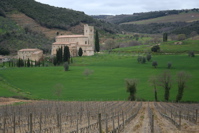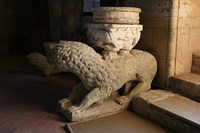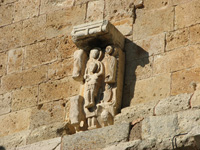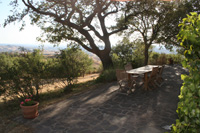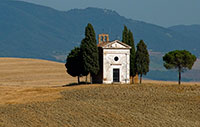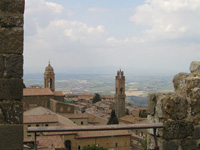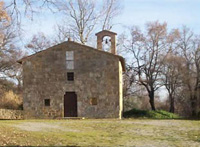Walking in Tuscany | Val d'Orcia [2]
|
| The Castle of Vivo d'Orcia lies in the widespread Orcia valley in southern Tuscany, 35 km north of Podere Santa Pia. The area surrounding Montalcino has been famed for centuries by artists and poets for its beautiful yet peaceful landscapes, comprising of soft rolling valleys and lightly peppered with olive groves and vineyards of superior quality. The Castle of Vivo d'Orcia lies in the widespread Orcia valley in southern Tuscany, 35 kmnorth of Podere Santa Pia. The name Vivo (meaning 'Alive') was adopted because of the lively, powerful industrial heart and from the wild and crashing river Vivo that ran through the village's six water-mills, once used for iron-works, olive crushing and fine paper production. The purity, power and potential of the river's water, pouring from the family's vast natural volcanic spring on Monte Amiata had long been harnessed by the Vatican who, via Pope Marcello II established a gigantic Papal Castle, using a rather illuminated architectural principal for its time, which aimed to make the Vatican's buildings more humble and more accessible to the local community Renaissance Palace (Palazzo), all designed by the famous 16th century architect of the Vatican Antonio da Sangallo for the Pope's living quarters. Vivo d'Orcia is a splendid outlying district of Castiglion d'Orcia, set in a valley outside time. At the foot of the castle, the river Vivo runs whose sources rise in the locality of Ermicciolo. Starting in the middle ages flour-mills, paper-mills and ironworks were built along the torrent and, in the 1920’s, one of the first hydroelectric power stations. Traces of these old buildings, covered with climbing plants, may still be seen here in one of the area’s most beautiful and evocative landscapes. |
|
||
Walking in Tuscany | Vivo d'Orcia - Vivo d'Orcia |
|||
This is not a particularly difficult itinerary, ideal even during the summer months, it almost completely unfolds among woodlands. Departure and arrival: Vivo d'Orcia Length: ca. 5 km Road surface: footpath and cart road Height difference: ca. 200 m Duration: 2 hours |
|||
From Vivo d'Orcia we start downhill toward the white-fir forest of Vivo d'Orcia, one of the last remaining in Tuscany of this kind. Very few houses are clustered around the XVI century Palazzo Cervini and the church of San Marcello. We proceed going back to the stone arch without crossing the stream, turning left on a footpath that starts at a gate and some stone steps that climb up to the fir-woods. We carry on for about 10 minutes up to a junction where we turn right along a path that leads to the asphalted road (Vivo-Seggiano). Here turning left we carry on downhill for about 200 m to another junction where the right turn will lead us steeply uphill to the equipped area of Lo Scudellino. Carrying on the footpath, lined by a wooden fence up to some boulders and a little bridge that crosses over the Mulino stream, we reach some picnic tables in a chestnut-woods. Climbing up among the huge chestnut trees the footpath becomes wider and leads us to a T-junction at which we turn right and cross a wooden bridge to reach a dirt road next to Sasso della Lupareccia. Here, making a right turn we arrive, uphill, at the Ermicciolo. The dirt road leads, with no problems, to the asphalted road that we take uphill and on the left, up to a second dirt road that will take us to the equipped area of the Ermicciolo. Following the main road we get to a stone aqueduct and through a flight of stairs, on the right, hidden among chestnut trees, we reach an attractive little Romanesque church (Chiesa dell'Ermicciolo) with both the façade and the apse decorated with small columns, and today private chapel of the Cervini family. Two drying kilns are at a stone's throw away from here. Leaving the little church behind, we proceed on the footpath that going through the woods, will lead us, in few minutes, to a dirt road in the proximity of a hairpin. We carry on the right, down to the asphalted road. From here it is either possible to go back to Vivo d'Orcia on the asphalted road for about 1 km or by the dirt road on our right, previously covered, that goes up to the junction with the asphalted road which, turning right, will lead us to the centre of Vivo d'Orcia. |
|
||
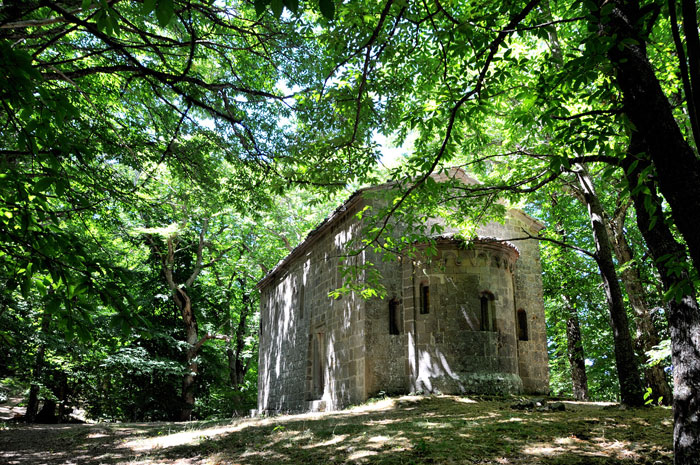 |
|||
Vivo d'Orcia | Eremo in estate [Copyright All rights reserved by Bruno Brunelli] |
|||
|
|
|||
Castelnuovo dell'Abate - Vivo d'Orcia |
|||
This spectacular itinerary descends from the Abbazia di Sant'Antimo, surrounded by silence and Brunello vineyards, then climbs up the pristine slopes of Monte Amiata, an ancient extinct volcano. The trip ends up in Vivo d'Orcia, one of the most well-conserved and verdant localities in Tuscany, charged with energy from the volcano. Departure at Abbazia di Sant'Antimo in Castelnuovo dell'Abate - Municipality of Montalcino Arrival at Vivo d'Orcia- Municipality of Castiglione d'Orcia Distance about 20 km |Duration: 3 and a half - 4 hours |
|||
The itinerary travels over some of the higher peaks in Terre di Siena. From the vineyards that run seamlessly down the slopes of Montalcino we walk downhill toward the Asso and Orcia waterways, to then climb up the shady green slopes of Monte Amiata, a venerable extinct volcano. This brief journey is also a voyage into spirituality that departs from the impressive Abbazia di Sant'Antimo, a paragon of stability amidst the rolling hills of Terre di Siena. It concludes in the intimate isolation of Vivo d'Orcia, adorned with ancient springs and the remains of a ruined Camaldolese hermitage. In the 12th century St. Romualdo had chosen to build his hermitage in Vivo, which he described as ' Wild and magnificent - a little highland at the point where the beech forests and chestnut forests meet, with a few level metres near a winding ravine, where two gushing springs of icy water thunder forth'. From the Abbazia di Sant'Antimo we proceed toward the hamlet of Bassomondi, then continue on the road for Casalta until we reach the farm of the same name. We cross the Siena-Monte Antico railroad tracks by passing over a tunnel, and then take on two crossings: the first over the Asso stream, which is deeper than it looks; the second over the Orcia river, which we cross opposite Podere Scarceta, where we then arrive by riding up a series of paths. The climb up toward the Strada Provinciale del Monte Amiata is cadenced by the Montelaccio, Finocchieto and Capanna farm-houses we pass along the way. The itinerary continues on this asphalted road as far as Madonna delle Querce, and then turns right along the aqueduct that supplies Siena with pure water from Monte Amiata. The final stretch leads to one of the most memorable spots on the mountain - the hermitage in Vivo d'Orcia. In addition to the Camaldolese hermitage itself, Vivo surprises visitors with its impressive fortified Renaissance palazzo attributed to Antonio Sangallo il Giovane. This is an enchanting place, with a double row of farmhouses and the remains of ruined artisan workshops along the river. Just opposite the palazzo, the Chiesa di San Pietro displays a façade in trachyte stone bearing the crest of the Cervini di Montepulciano family, the powerful local nobility.
|
|
||
|
|||
Dalla val d'Orcia alle pendici del Monte Amiata I grandi sentieri della provincia di Siena Attraverso i paesaggi della Val d'Orcia fino ai boschi dell'Amiata |
|||
Mappa Val d'Orcia | Ingrandire mappa |
The abbey of Sant’Antimo |
||
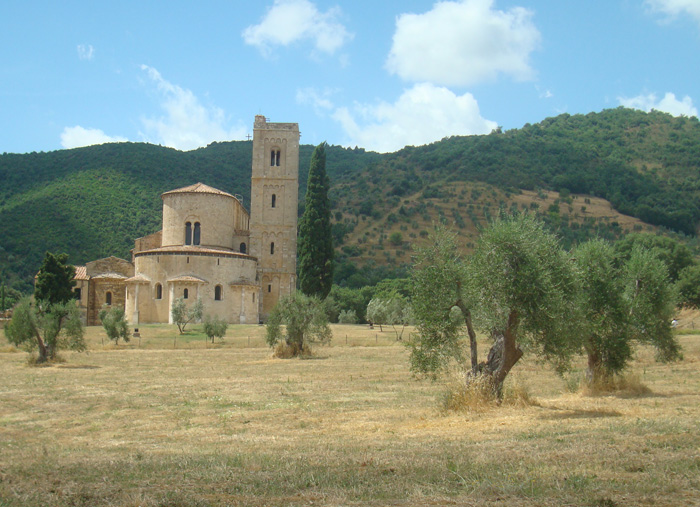 |
||
The Abbey of Sant'Antimo |
||
In addition to its sleepy medieval streets and sun-soaked vineyards, Montalcino presents other sights such as the Piazza del Popolo (People’s Square) and the Palazzo dei Priori (old Town Hall), as well as the medieval churches of San Francesco, San Egidio and San Agostino. The city’s fortezza (fortress) is almost perfectly preserved. The Cathedral (of San Salvatore) and the Diocesano Museum are full of sacred works of art by 11th to 16th century painters, and contain other medieval objects and archeological artifacts from San Antimo Abbey (which is located 10 km from Montalcino). |
||
| The façade, which remains incomplete, houses a portal, probably one of a pair planned originally, surmounted by a lintel datable to the first half the 12th century, together with capitals, friezes and ferrules. The element that confers a French imprint on this church more than any other is the basilical ground plan, an ambulatory with radial chapels, unique in Tuscany and among the few present in Italy. A study of Sant’Antimo was made by the art historian Raspi-Serra, and completed in the 1960’s. It brought us to conclude that the portal on the left side of the church of Santa Maria in San Quirico d’Orcia (approximately 20 km from Saint’Antimo), is none other than one of the two portals intended for the abbey. Perhaps the monastery, at that time, already in a state of decline, decided to give over the second portal to this other church. The entrance has a high arch, and bas-relief decorations. Particularly interesting is the small doorway to the left; this dates back to the 9th century. Also on this side is the Bell Tower, with single-light and double-light windows. One of the bells dates back to 1219. The pre-Romanesque primitive chapel is visible on the right. The interior has three naves separated by high columns, alternated with pilasters in clusters in the lower part and twin lancet galleries above. The capitals in marble from the nearby Castelnuovo quarry are decorated with floral, human and geometric figures. The apse has radial chapels joined by an ambulatory, as in French Cathedrals. The church is guarded at the entry by two stylised lions, probably destined for the external portal, datable to the 12th century and attributed to the Master of Cabestany, as is the splendid capital with the scenes of Daniel in the lions." The refined geometrical and leaf motifs, precise in outline and cleanly carved, indicate an origin in Auvergne. To the right of the larger church, set at the beginning of the ambulatory, there is a Carolingian chapel of the 8th or 9th century, a small building with a single rectangular aisle and a semicircular apse. Outside on the left, the imposing bell tower rise to around 30 m, divided into four orders, decorated in Lombard style with a with a hint of Pisan taste in the columns at the angles of the base. The bell tower houses two bells, one of which is engraved with Abbot Ugo's name (1216-1222) and the date 1219. |
The church is guarded at the entry by two stylised lions, probably destined for the external portal, datable to the 12 C and attributed to the Master of Cabestany, as is the splendid capital with the scenes of Daniel in the lionsden." The refined geometrical and leaf motifs, precise in outline and cleanly carved, indicate an origin in Auvergne.
|
|
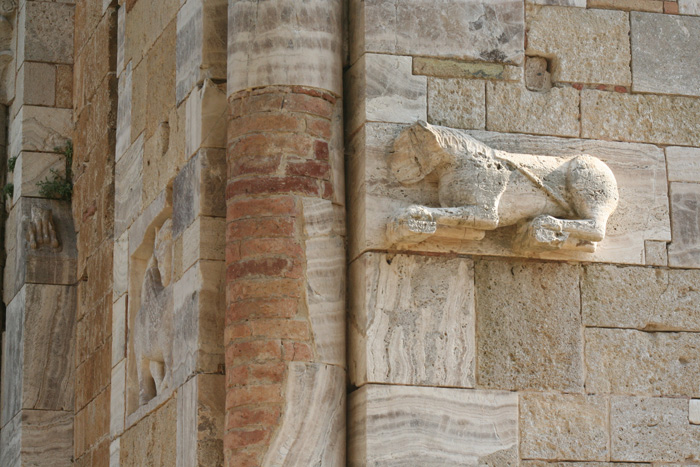 |
||
The Abbey of Sant'Antimo was constructed on the site of a Roman villa. In the 4th and 5th centuries the village of Castelnuovo dell'Abate,
|
||
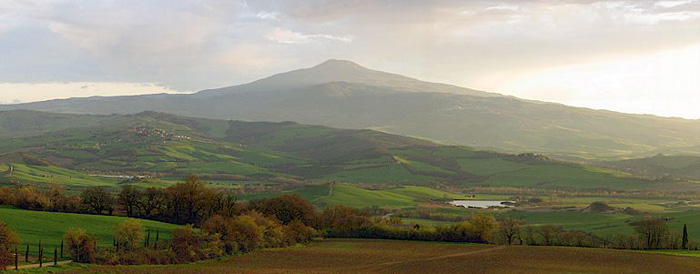 |
||
The Val d'Orcia between Pienza and Monte Amiata, view to the west from La Foce. The territory of the Val d'Orcia is made up, mainly of a hilly landscape with gently rolling hills and valleys typical of the Sienese Crete and a rich variety of vegetation. |
||
|
||||
Podere Santa Pia |
Podere Santa Pia |
Madonna di Vitaleta Chapel, San Quirico d'Orcia |
||
Pienza |
Montalcino |
Pieve di Santa Maria dello Spino |
||
|
||||

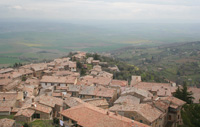

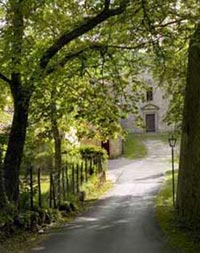
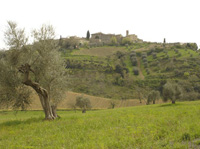 Castelnuovo dell'Abate
Castelnuovo dell'Abate